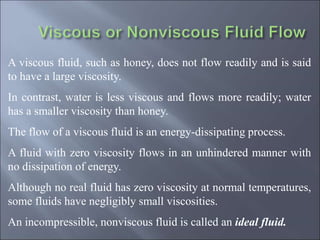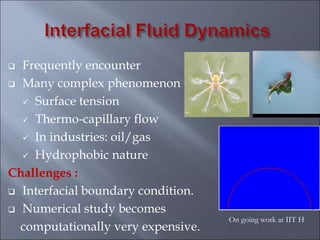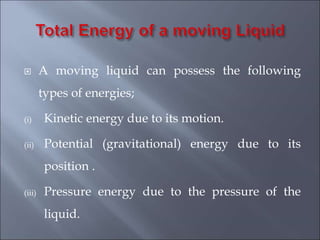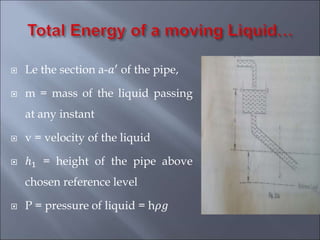Introduction of Fluid Mechanics
- 1. INTRODUCTION TO FLUID DYNAMICS Peter Huruma Mammba Department of General Studies DODOMA POLYTECHNIC OF ENERGY AND EARTH RESOURCES MANAGEMENT (MADINI INSTITUTE) –DODOMA peter.huruma2011@gmail.com
- 2. Introduction (Definitions of fluid, Stresses, Types of fluids, Newton’s law of viscosity, Laminar flow, Turbulent flow, Rate flow, Equation of continuity, Bernoulli's equation, Total energy) Where you find Fluids and Fluid-Dynamics? Blood flow in arteries and veins Interfacial fluid dynamics Geological fluid mechanics The dynamics of ocean Laminar-turbulent transition Solidification of fluids
- 3. Vortex shedding off back of Sorrocco Island
- 4. is a sub discipline of fluid mechanics that deals with fluid flow. i.e. the science of fluids (liquids and gases) in motion. It has several sub disciplines itself, including aerodynamics (the study of air and other gases in motion) and hydrodynamics (the study of liquids in motion)
- 5. First (the fluid is nonviscous) Means, there is no internal frictional force between the adjacent layers of the fluid
- 6. A viscous fluid, such as honey, does not flow readily and is said to have a large viscosity. In contrast, water is less viscous and flows more readily; water has a smaller viscosity than honey. The flow of a viscous fluid is an energy-dissipating process. A fluid with zero viscosity flows in an unhindered manner with no dissipation of energy. Although no real fluid has zero viscosity at normal temperatures, some fluids have negligibly small viscosities. An incompressible, nonviscous fluid is called an ideal fluid.
- 7. Secondly, (the fluid is incompressible) This means that the velocity , density and pressure at each point in the fluid do not change with time. NB. Such simplifying assumption s permit us to study the flow of fluid in a simple way.
- 8. Most liquids are nearly incompressible; that is, the density of a liquid remains almost constant as the pressure changes. To a good approximation, then, liquids flow in an incompressible manner. In contrast, gases are highly compressible. However, there are situations in which the density of a flowing gas remains constant enough that the flow can be considered incompressible.
- 10. Substances with no strength Deform when forces are applied Include water and gases Solid: Deforms a fixed amount or breaks completely when a stress is applied on it. Fluid: Deforms continuously as long as any shear stress is applied.
- 11. The study of motion and the forces which cause (or prevent) the motion. Three types: Kinematics (kinetics): The description of motion: displacement, velocity and acceleration. Statics: The study of forces acting on the particles or bodies at rest. Dynamics: The study of forces acting on the particles and bodies in motion.
- 12. Stress = Force /Area Shear stress/Tangential stress: The force acting parallel to the surface per unit area of the surface. Normal stress: A force acting perpendicular to the surface per unit area of the surface.
- 13. Basic laws of physics: Conservation of mass Conservation of momentum – Newton’s second law of motion Conservation of energy: First law of thermodynamics Second law of thermodynamics + Equation of state Fluid properties e.g., density as a function of pressure and temperature. + Constitutive laws Relationship between the stresses and the deformation of the material.
- 14. Example: Density of an ideal gas Ideal gas equation of state Newton’s law of viscosity: 2 3 PV=nRT, P: pressure (N/m ),V: volume(m ), T:temperature(K),n:number of moles. mass nM = V V pM = RT Stress α train (deformation) du du = dy dy S : coefficientof viscosity(Dynamicviscosity)
- 15. It is define as the resistance of a fluid which is being deformed by the application of shear stress. In everyday terms viscosity is “thickness”. Thus, water is “thin” having a lower viscosity, while honey is “think” having a higher viscosity. Common fluids, e.g., water, air, mercury obey Newton's law of viscosity and are known as Newtonian fluid. Other classes of fluids, e.g., paints, polymer solution, blood do not obey the typical linear relationship of stress and strain. They are known as non-Newtonian fluids. Unit of viscosity: Ns/m2 (Pa.s)
- 16. Very Complex Rheology of blood Walls are flexible Pressure-wave travels along the arteries. Frequently encounter bifurcation There are vary small veins
- 17. Frequently encounter Many complex phenomenon Surface tension Thermo-capillary flow In industries: oil/gas Hydrophobic nature Challenges : Interfacial boundary condition. Numerical study becomes computationally very expensive. On going work at IIT H
- 19. When a viscous fluid flows over a solid surface, the fluid elements adjacent to the surface attend the velocity of the surface. This phenomenon has been established through experimental observations and is known as “no-slip” condition. Many research work have been conducted to understand the velocity slip at the wall, and has been continued to be an open topic of research.
- 20. Fluids can move or flow in many ways. Water may flow smoothly and slowly in a quiet stream or violently over a waterfall. The air may form a gentle breeze or a raging tornado. To deal with such diversity, it helps to identify some of the basic types of fluid flow.
- 21. When the pressure is lower on one side of a fluid than on other side, the fluid will flow toward the low-pressure region. Fluid flow is characterized by two main types;- (i) Steady flow or streamline flow (ii) Turbulent flow
- 22. If the flow of fluid is steady, then all the fluid particles that pass any given point follow the same path at the same speed. i.e… they have the same speed
- 23. In steady flow the velocity, density and pressure of the fluid particles at any point is constant as time passes. Unsteady flow exists whenever the velocity at a point in the fluid changes as time passes.
- 24. When the flow is steady, streamlines are often used to represent the trajectories of the fluid particles. A streamline is a line drawn in the fluid such that a tangent to the streamline at any point is parallel to the fluid velocity at that point. Steady flow is often called streamline flow.
- 25. (a) In the steady flow of a liquid, a colored dye reveals the streamlines. (b) A smoke streamer reveals a streamline pattern for the air flowing around this pursuit cyclist, as he tests his bike for wind resistance in a wind tunnel.
- 26. This is the special case of steady flow in which the velocities of all the particles on any given streamline are the same through the particles of different streamlines may be move at different speed.
- 27. Also known as streamline flow Occurs when the fluid flows in parallel layers, with no disruption between the layers The opposite of turbulent flow (rough)
- 28. In fluid dynamics (scientific study of properties of moving fluids), laminar flow is: A flow regime characterized by high momentum diffusion, low momentum convection, pressure and velocity independent from time. *momentum diffusion refers to the spread of momentum (diffusion) between particles of substances, usually liquids
- 29. Laminar flow over a flat and horizontal surface can be pictured as consisting of parallel and thin layers Layers slide over each other, thus the name ‘streamline’ or smooth. The paths are regular and there are no fluctuations Laminar Flow Turbulent Flow
- 30. 3 Conditions fluid moves slowly viscosity is relatively high flow channel is relatively small Blood flow through capillaries is laminar flow, as it satisfies the 3 conditions Most type of fluid flow is turbulent There is poor transfer of heat energy!
- 32. Turbulent flow is an extreme kind of unsteady flow and occurs when there are sharp obstacles or bends in the path of a fast-moving fluid. In turbulent flow, the velocity at a point changes erratically from moment to moment, both in magnitude and direction.
- 33. Usually occurs when the liquid is moving fast The flow is ‘chaotic’ and there are irregular fluctuations Includes: Low momentum diffusion high momentum convection rapid variation of pressure and velocity of the fluid Good way to transfer
- 34. The speed of the fluid at a point is continuously undergoing changes in both magnitude and direction.
- 35. Oceanic and atmospheric layers and ocean currents External flow of air/water over vehicles such as cars/ships/submarines In racing cars, e.g. leading car causes understeer at fast corners Turbulence during air-plane’s flight Most of terrestrial atmospheric circulation Flow of most liquids through pipes
- 37. This is the volume of a liquid that passes the cross-section per unit time. It is denoted by the symbol Q 𝑅𝑎𝑡𝑒 𝑜𝑓 𝑓𝑙𝑜𝑤, 𝑄 = 𝑉 𝑡 The SI unit of rate of flow is 𝑚3 𝑠−1
- 38. Consider a pipe of uniform cross-sectional area 𝐴1 as shown in figure below If the pipe is running full with liquid at an average velocity of 𝑣1, then distance 𝑙 through which the liquid moves in time t, it rate of flow will be;- 𝑄 = 𝑉 𝑡 = 𝐴1 𝑥 𝑣1 𝑡 𝑡 𝑄 = 𝐴1 𝑣1 (also called discharge equation)
- 39. The Reynolds number Re is the ratio of the inertia forces in the flow to the viscous forces in the flow and can be calculated using: • If Re < 2000, the flow will be laminar. • If Re > 4000, the flow will be turbulent. • If 2000<Re<4000, the flow is transitional • The Reynolds number is a good guide to the type of flow
- 40. μ is the dynamic viscosity of the fluid v is the kinematic velocity of the fluid A is the pipe cross-sectional area. p is the density of the fluid V is the mean fluid velocity D is the diameter Q is the volumetric flow rate Dynamic Pressure Shearing Stress
- 41. The Reynold’s number can be used to determine if a flow is laminar, transient or turbulent Laminar when Re < 2300 Turbulent when Re > 4000 Transient when 2300 < Re < 4000 Spermatozoa 1×10−4 Blood flow in brain 1×102 Blood flow in aorta 1×103
- 42. Q: Have you ever used your thumb to control the water flowing from the end of a hose?
- 43. Q: Have you ever used your thumb to control the water flowing from the end of a hose? A: When the end of a hose is partially closed off, thus reducing its cross-sectional area, the fluid velocity increases. This kind of fluid behavior is described by the equation of continuity.
- 45. Water flows through a horizontal pipe of varying cross-section at the rate of 10 𝑚3 /minutes. Determine the velocity of water at point where the radius of the pipe is 10 cm.
- 46. Rate of discharge, Q = 10 𝑚3 /minutes = 1 6 𝑚3 /s Cross-sectional area, A = 𝜋𝑟2 = 𝜋 0.1 2 = 0.0314𝑚2 Q = Av Velocity of water, v = 𝑄 𝐴 = 1 6 0.0314 = 5.3 m/s
- 47. Water flows through a pipe of internal diameter 20 cm at the speed of 1 m/s. what should the diameter nozzle be if the water is to emerge at the speed of 4 m/s ?
- 48. Here 𝑑1 = 20 cm = 0.2 m; 𝑣1 = 1 m/s; 𝑣2 = 4 m/s; 𝑑2 = ? 𝐴1 𝑣1 = 𝐴2 𝑣2 𝜋 4 𝑑1 2 𝑣1 = 𝜋 4 𝑑2 2 𝑣2 𝑑2 2 𝑑1 2 = 𝑣1 𝑣2 = 1 4 𝑑1 𝑑2 = 1 2 𝑑2 = 𝑑1 2 = 0.2 2 = 0.1 m = 10 cm
- 49. Water is flowing through a horizontal pipe of varying cross-sectional at the rate of 20 liters per minutes. Find the velocity of water at a point where diameter of the pipe is 2 cm. Answer 10.61 m/s
- 50. A water pipe is 10 cm in diameter and has a construction of 2 cm diameter. If the velocity of flow in the main pipe is 0.84 m/s, calculate (i) the velocity of flow in the construction (ii) rate of discharge of water through the pipeline. Answer (i) 21 m/s (ii) 0.0066 𝑚3/𝑠
- 51. A moving liquid can possess the following types of energies; (i) Kinetic energy due to its motion. (ii) Potential (gravitational) energy due to its position . (iii) Pressure energy due to the pressure of the liquid.
- 52. Figure 23.6 shows the flow of liquid of density 𝜌 from a tank to a pipe; the water level AB in the tank being kept constant
- 53. Le the section a-𝑎′ of the pipe, m = mass of the liquid passing at any instant v = velocity of the liquid ℎ1 = height of the pipe above chosen reference level P = pressure of liquid = h𝜌𝑔
- 54. At the section a- 𝑎′ of the pipe, the liquid has various energies as under; Kinetic energy (K.E.) = 1 2 𝑚𝑣2 Potential energy (P.E.) = mgℎ1 Pressure energy = mgh where (P = h𝜌𝑔) = 𝑚𝑔 𝑥 𝑃 𝜌𝑔 = 𝑚𝑃 𝜌
- 55. ∴ 𝑇𝑜𝑡𝑎𝑙 𝑒𝑛𝑒𝑟𝑔𝑦 𝑎𝑡 𝑠𝑒𝑐𝑡𝑖𝑜𝑛 a-𝑎′ =; 1 2 𝑚𝑣2 + mgℎ1 + 𝑚𝑃 𝜌 ∴ 𝑇𝑜𝑡𝑎𝑙 𝑒𝑛𝑒𝑟𝑔𝑦 𝑝𝑒𝑟 𝑢𝑛𝑖𝑡 𝑚𝑎𝑠𝑠 𝑎𝑡 a-𝑎′ =; 1 2 𝑣2 + gℎ1 + 𝑃 𝜌 ∴ 𝑇𝑜𝑡𝑎𝑙 𝑒𝑛𝑒𝑟𝑔𝑦 𝑝𝑒𝑟 𝑢𝑛𝑖𝑡 𝑣𝑜𝑙𝑢𝑚𝑒 𝑎𝑡 a-𝑎′ =; 1 2 𝜌𝑣2 + 𝜌gℎ1 + 𝑃
- 57. For steady flow, the speed, pressure, and elevation of an incompressible and nonviscous fluid are related by an equation discovered by Daniel Bernoulli (1700–1782).
- 58. In the steady flow of a nonviscous, incompressible fluid of density , the pressure P, the fluid speed v, and the elevation y at any two points (1 and 2) are related by
- 59. The tarpaulin that covers the cargo is flat when the truck is stationary but bulges outward when the truck is moving.
- 60. In a household plumbing system, a vent is necessary to equalize the pressures at points A and B, thus preventing the trap from being emptied. An empty trap allows sewer gas to enter the house.
- 63. At what speed will the velocity head of a stream of water be equal to 40 cm?
- 64. Velocity head, 𝑣2 2𝑔 = h v = 2𝑔ℎ Here g = 9.8 m/s.s; h = 40 cm = 0.4 m v = 2 𝑥 9.8 𝑥 0.4 v = 2. 8 m/s
- 65. A pipe is running full of water. At a certain point A, it tapers from 60 cm diameter to 20 cm diameter at B; the pressure different between A and B is 100 cm of water column. Find the rate of flow through the pipe.
- 66. 𝑎 𝐴 𝑎 𝐵 = 𝑑 𝐴 𝑑 𝐵 2 = 0.6 0.2 2 = 9 𝑃𝐴 − 𝑃𝐵 = 𝐻𝜌𝑔 = 1 𝑥 1000 𝑥 9.8 = 9800𝑁/𝑚2 𝑣 𝐴 𝑎 𝐵 = 𝑣 𝐵 𝑎 𝐵 𝑣 𝐵 = 𝑣 𝐴 𝑎 𝐴 𝑎 𝐵 = 9𝑣 𝐴
- 67. Using Bernoulli’s theorem for a horizontal pipe, 𝑃 𝐴 𝜌 + 1 2 𝑣 𝐴 2 = 𝑃 𝐵 𝜌 + 1 2 𝑣 𝐵 2 1 𝜌 𝑃𝐴 − 𝑃𝐵 = 1 2 𝑣 𝐵 2 − 𝑣 𝐴 2 𝑃𝐴 − 𝑃𝐵= 1 2 𝑣 𝐵 2 − 𝑣 𝐴 2
- 68. 9800 = 100 2 81𝑣 𝐴 2 − 𝑣 𝐴 2 ∴ 𝑣 𝐵 = 9𝑣 𝐴 9800 = 40000𝑣 𝐴 2 𝑣 𝐴 = 9800 40000 = 0.495 m/s Rate of discharge, Q = 𝑣 𝐴 𝑎 𝐴 = 0.495 x 𝜋 4 0.6 2 = 0.14 𝑚3 /𝑠





































































